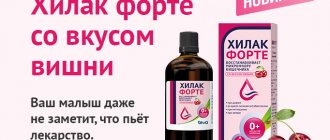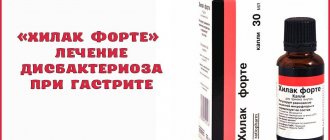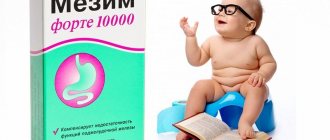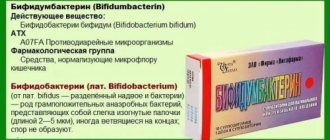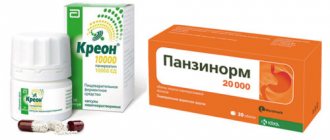Mom's life is difficult. Feed, wash, change, play, put to bed. But life for a toddler is even more difficult. New world, new sensations, new problems. And the beginning of life does not always proceed without health problems.
Intestinal colic due to imperfections of the digestive system is not so bad. But often the birth is accompanied by various conditions for which antibiotics and other aggressive substances are indicated. And the microflora that has not yet been properly formed dies irrevocably, giving rise to new problems with the gastrointestinal tract, dysbacteriosis in the oral cavity and genitals.
To restore the microflora, children are prescribed the drug “Hilak Forte”. How to give Hilak Forte to a newborn?
Composition, pharmaceutical group, mechanism of action
Hilak forte normalizes the composition and quality of beneficial microorganisms.
This medicine belongs to a group of drugs that affect the microflora of the body. Hilak
Forte is produced only in the form of yellowish drops. The smell is pungent, slightly sour. This is not a sign of damage. The drops contain substrates of cultures living in the human gastrointestinal tract:
- Escherichia coli
- Enterobacteriaceae
- Lactobacilli 2 species
- Additional substances - lactic and phosphoric acids, sodium and potassium salts
- The drug is produced in 2 packages - 30 ml and 100 ml. Dark glass bottles with a dropper.
The microflora of the intestines, mouth, and genitals reacts sensitively to changes in the living conditions of its owner. Antibiotics, sulfonamides, even stress and the body reacts with the death of beneficial bacteria. At the same time, opportunistic flora, which is a habitual inhabitant of the body, begins to multiply. Inflammatory processes occur and general immunity decreases.
The components of Hilak Forte normalize the composition and quality of beneficial microorganisms.
Additional components - acids and salts - bring the pH of gastric juice to normal levels, regardless of its initial acidity. As a result, the body independently resumes the synthesis of B vitamins and vitamin K, and the body’s overall resistance to infectious diseases increases.
In infants of the first year of life diagnosed with salmonella enteritis, the drug promotes accelerated removal of the pathogen from the body and replacement of opportunistic flora with normal acidophilic flora.
Hilak forte
Hilak ® forte
(lat.
Hylak® forte
) is an antidiarrheal drug. Available in the form of drops for oral administration in dropper bottles of 30 or 100 ml.
Composition of the drug Hilak forte
The active substance of
Hilaka forte is an embryoless aqueous substrate of metabolic products of the following bacteria, containing, in terms of 100 ml:
- Escherichia coli ( Escherichia coli
) DSM 4087 - 24.9481 g - Enterococcus faecium
DSM 4086 - 12.4741 g - lactobacilli acidophilus ( Lactobacillus acidophilus
) DSM 4149 - 12.4741 g - Lactobacillus helveticus ( Lactobacillus helveticus
) DSM 4183 - 49.8960 g
Excipients
: lactic acid 90%, sodium phosphate, potassium phosphate, phosphoric acid 85%, citric acid monohydrate, potassium sorbate.
Pharmacological action of the drug Hilak forte
Hilak forte helps to establish stomach acidity within the physiological norm.
Using biosynthetic lactic acid in an enriched buffer system, a shift in acidity to physiological values for a given section of the intestine is achieved, which creates unfavorable conditions for pathogenic and opportunistic bacteria. The products of bacterial biosynthesis contained in Hilak Fort help maintain the physiological function of the intestinal mucosa. Due to the antagonistic effect against pathogenic and accelerated growth of normal intestinal microflora, the composition of the intestinal microflora is normalized, which is achieved due to the metabolic products of gram-positive and gram-negative obligate intestinal microorganisms contained. Lactic acid and metabolic products of antagonist microorganisms help maintain the sterility of the stomach and upper parts of the small intestine. Hilak Forte promotes the rapid restoration of optimal intestinal flora, disturbed during the use of sulfonamides, antibiotics and other antimicrobial drugs. Hilak forte, due to the growth of acidophilic anaerobic intestinal flora, reduces the period of elimination of Salmonella after Salmonella enteritis. The metabolic products of natural intestinal bacteria contained in Hilak Forte regulate the balance of the intestinal microbiota, normalizes its composition, contributes to the restoration of normal intestinal microflora and allows maintaining the physiological and biological functions of the intestinal mucosa. The acids and their salts included in Hilak Forte restore normal acidity in the intestines, regardless of the patient’s acidity level, thereby helping to destroy harmful microorganisms.
Against the background of accelerating the development of friendly intestinal microflora under the influence of Hilak forte, the natural synthesis of vitamins B and K is normalized. The short-chain volatile fatty acids contained in the preparation ensure the restoration of damaged intestinal microflora in infectious diseases of the gastrointestinal tract, stimulate the regeneration of epithelial cells of the intestinal wall, and restore disturbed water-electrolyte balance in the intestinal lumen.
When using Hilak forte, there is an acceleration of the elimination of Salmonella in infants after Salmonella enteritis, which is due to stimulation of the growth of acidophilic anaerobic flora and its subsequent antagonistic effect on Salmonella.
Professional medical publications addressing the use of the drug Hilak Forte in the treatment of the gastrointestinal tract
- Shcherbakov P.L. Issues in pediatric gastroenterology.
- Kulikova L.E., Pogorelsky I.P., Mokretsova I.M., Chicherin I.Yu. Characteristics of the antibacterial activity of the biocomplexes “Normoflorins” and the probiotic of the metabolite type Hilak forte against microorganisms isolated from the oral cavity // Eurasian Union of Scientists. 2014. VIII. pp. 126–129.
On the website in the literature catalog there is a section “Probiotics, prebiotics, synbiotics, symbiotics”, containing articles on the treatment of diseases of the gastrointestinal tract with probiotics, prebiotics and synbiotics.
Indications for use of the drug Hilak forte
- disturbances of the physiological intestinal microflora (during and after treatment with antibiotics, sulfonamides, radiation therapy);
- digestive insufficiency syndrome, dyspepsia;
- diarrhea, flatulence, constipation;
- gastroenteritis, colitis;
- senile intestinal syndrome (chronic, atrophic gastroenteritis);
- gastrointestinal disorders caused by climate change;
- hypo- and anacid states;
- enterogenous diseases of the gallbladder and liver;
- allergic skin diseases (urticaria, endogenously caused chronic eczema);
- salmonellosis in the convalescent stage (including in infants).
Dosage regimen Hilak forte:
- For adults, the drug is prescribed 40-60 drops 3 times a day;
- children - 20-40 drops 3 times a day;
- infants - 15-30 drops 3 times a day.
After the condition improves, the initial daily dose of Hilak Forte can be reduced by half. The drug is taken orally before or during meals, diluted in a small amount of liquid, excluding milk.
Side effects of Hilak forte:
- From the digestive system: constipation, diarrhea are possible.
- Allergic reactions: possible skin rash, itching, urticaria.
Contraindications to the use of the drug Hilak forte
Hypersensitivity to the components of the drug.
Use of the drug Hilak forte during pregnancy and breastfeeding.
The use of Hilak Forte during pregnancy and lactation (breastfeeding) is considered safe.
The decision to prescribe the drug is made by the doctor. Special instructions.
It is not recommended to take the drug simultaneously with milk and dairy products.
Overdose.
No special measures are required other than routine medical supervision.
Drug interactions.
When used simultaneously with antacids, it is possible to neutralize lactic acid, which is part of the drug Hilak Forte.
Hilak forte is an over-the-counter product.
According to the pharmacological index, Hilak forte belongs to the group “Medicines that normalize intestinal microflora”. For ATC - to the group “Antidiarrheal microorganisms”, code A07FA.
Manufacturer: Merckle GmbH (Merckle, GmbH), Germany. Back to section
When should you take the drug?
Hilak forte is used to treat gastritis.
This drug is used in the treatment of diseases associated with an imbalance in the ratio of beneficial and pathogenic microorganisms. The drug is indicated in the following cases:
- Changes in microflora due to aggressive treatment of any disease, radiation, stressful situation
- Dyspeptic problems - constipation, diarrhea, flatulence, belching, nausea
- Inflammatory diseases of the gastrointestinal tract - gastritis, enteritis, colitis
- Pathologies of the liver, biliary tract
- Allergies - hives, rashes, eczema, provoked by external irritants
- Salmonellosis during the recovery period
There is only one contraindication for treatment - individual intolerance to the components of Hilak Forte drops. Pregnancy and breastfeeding are not considered a contraindication, but a doctor must decide whether to prescribe the drug.
Side effects when using the drug occur extremely rarely. Allergic reactions and defecation disorders, both constipation and diarrhea, have been reported in the literature. All unpleasant phenomena went away on their own after discontinuation of the drug.
Currently, ideas about intestinal dysbiosis (ID), its prevention and correction are being radically revised. The term “dysbacteriosis” is very actively and often erroneously used in pediatrics, which is why the prevalence of microflora disorders in children turns out to be extremely overestimated (according to the literature, 50–100%). This phenomenon is due to several reasons. Firstly, there is no simplicity and clarity in understanding the essence of DC. Secondly, DC can manifest itself with the same symptoms as diseases of the gastrointestinal tract (GIT).
Despite the fact that DC as a nosological entity has long acquired the right to exist, its place among other diseases has not been determined to this day. DC is not considered as a nosological entity in the International Classification of Diseases (ICD-10). This fact is not accidental, because from a modern point of view, any dysbacteriosis is considered not an independent disease, but a manifestation of many pathological conditions in which the species composition of the microflora in a particular biotope of the human body is disrupted.
According to the Russian industry standard of 2003, DC is defined as a clinical and laboratory syndrome that occurs in a number of diseases and conditions, characterized by changes in the qualitative and/or quantitative composition of the gastrointestinal microflora, metabolic and immunological disorders, and is accompanied in some patients by symptoms of gastrointestinal diseases [25] .
Etiology and pathogenesis of intestinal dysbiosis
The main of the various causes of DC in children is the use of antibiotics, which suppress the vital activity of intestinal microorganisms and change the composition of the gastrointestinal microflora. Under the influence of antibiotics, species characterized by pathogenicity factors begin to predominate in the microflora: increased adhesiveness, high metabolic activity, production of enterotoxins, and multidrug resistance.
Significant changes in the biocenoses of the gastrointestinal tract occur as a result of inflammatory diseases of the small and large intestines of both infectious and non-infectious nature. A significant role is played by transient functional disorders of the biliary tract, as well as fermentopathy and allergic damage to the gastrointestinal mucosa. Age is of great importance: in young children, DC develops faster, which is associated with the relative enzymatic deficiency of the gastrointestinal tract and the immaturity of the child’s immune system.
There are cause-and-effect relationships between the state of the ecosystem of the human body and natural, climatic and man-made factors. The unfavorable effect of these factors is partially blocked by adaptive reactions, which are labile in childhood. For example, children living in environmentally unfavorable regions experience serious disturbances in microbial colonization of the nasopharynx, oropharynx, and colon [24]. They are characterized by changes in the density and composition of the microflora, the appearance of opportunistic microorganisms unusual for the specified biotopes, and the predominant growth of gram-negative bacteria. Ecopathogenic factors can trigger the expression of atypical properties of microorganisms, increase the level of mutations, lead to the formation of new biocenoses and thereby disrupt the state of symbiosis. Against this background, the composition of the microflora changes not only in the gastrointestinal tract, but also in the skin, urinary tract, and reproductive system towards gram-negative bacteria. It is important to note that gram-negative bacteria, compared to gram-positive bacteria, are stronger immunogens for the child’s body and are more resistant to broad-spectrum antibiotics.
When the microflora is disturbed, strains of opportunistic bacteria appear, which can aggravate the course of intercurrent diseases when the child’s immunity is weakened. In parallel, a deficiency of bifidobacteria and lactobacilli occurs, as a result of which natural protective mechanisms are disrupted: the barrier properties of microflora, the gastrointestinal mucosa and immunity [2, 4, 6, 8].
Principles of correction of intestinal dysbiosis
Today, the best developed use of probiotics - medicines, biologically active additives and food products based on living microorganisms - representatives of normal microflora [3, 5, 9, 10, 12, 14, 20, 21, 27, 28, 30, 31, 34, 35]. In modern medicine, probiotics are defined as viable organisms and/or substances of microbial or other origin that, when administered naturally, have beneficial effects on the physiological functions, biochemical and behavioral reactions of the host through optimizing its microbiological status [36, 38–40].
The founder of the concept of probiotics was I.I. Mechnikov, who was awarded the Nobel Prize for a series of works in this direction in 1908. Since then, many microorganisms have been studied that could be part of medicines and food products, but only a few have been approved for medical use. The main criterion for suitability is the probiotic effect, proven in double-blind controlled trials. The probiotic effect of Bifidobacterium bifidum, Lactobacillus acidophilus, Lactobacillus GG, Lactobacillus fermentum, Strepto(Entero)coccus faecium SF68, Streptococcus termophilus, Saccharomyces boulardii has been reliably proven. The listed microorganisms are included in numerous drugs presented on the pharmaceutical market in a variety of forms (tablets, suppositories, ointments, creams, injection forms). Complex preparations are produced that also contain interferon, immunoglobulins, and vitamins. New generation probiotics are being created based on microbial metabolites, as well as microorganisms with specified properties using genetic engineering methods. The first such probiotic, Subalin, along with high antibacterial activity against a wide range of pathogenic and opportunistic microorganisms, also has antiviral properties.
Probiotics entering the gastrointestinal tract change not only the composition, but also the function of the microflora [31, 37, 39, 40]. Many probiotic bacteria protect the host’s body in two ways: they form a barrier that prevents the attachment of pathogenic microorganisms to the gastrointestinal mucosa and stimulate the immune system. These effects are mediated by direct antagonism of bacteria and enhancement of the immune response. At the same time, phagocytic activity increases, the number of B- and T-lymphocytes, and the levels of cytokines and immunoglobulins increase. Such effects are characteristic, for example, of L. casei [6]. Another proven effect of probiotics is improving the breakdown and absorption of lactose. S. thermophilus and L. bulgaricus have these properties [30, 33].
Strict requirements are imposed on preparations containing live microorganisms: microorganisms must be normal representatives of the human microflora with accurate taxonomic identification; cannot be pathogenic or toxic; the therapeutic effect must be confirmed by clinical trials; with long-term use should not have side effects; must be maintained in the gastrointestinal tract until maximum effect is achieved [27–29, 32].
In the literature of recent years, reports are increasingly appearing that the effect of probiotics, even with long-term use, is often transient. There are reports that some lactobacilli and even bifidobacteria can be opportunistic or cause disturbances in the normal microflora. In this regard, recommendations are being developed for assessing in vitro the biocompatibility of probiotics with the microflora of a child who is supposed to be prescribed probiotic therapy. This technique, reminiscent of testing the sensitivity of bacteria to antibiotics, allows you to select the most effective probiotics with minimal side effects.
Selecting a probiotic for empirical correction of DC is a rather difficult task, since many of them are ineffective. This may be due to the rapid death of the introduced strains due to the high aggressiveness of the immune system towards its own microflora. The use of some probiotics is limited by their high price, although pharmacoeconomic studies indicate that the cost of probiotics accounts for a relatively modest contribution to the overall cost of treatment.
Characteristics of the drug Hilak forte
Many problems of DC correction can be resolved through the development and implementation of fundamentally new drugs - microbial metabolites. The first representative of this group was Hilak forte (ratiopharm company, Germany). The structural features provide its advantages over probiotics from a pharmacokinetic point of view. The expediency of including Hilak Forte in the category of promising means of correction of CD is based primarily on the fact that it has a variety of biological activities. Russian doctors who studied the effectiveness of the drug came to the conclusion that the effects of Hilak Forte are realized not only at the level of the gastrointestinal tract, but also the body as a whole.
An important property of Hilak Forte is its good tolerability with a minimum of side effects, which allows the drug to be prescribed to newborns, young children, as well as pregnant and lactating women. According to a survey we conducted, in which pediatricians, pediatric gastroenterologists and general practitioners from different districts of the Moscow region participated, young children with gastrointestinal disorders are most often prescribed Hilak Forte. The drug is produced in a special children's form, which makes it easy to follow the dosage regimen depending on the age of the child.
The high efficiency and good tolerability of Hilak Forte made it possible to conduct controlled clinical trials in the shortest possible time involving a large number of patients of different ages [18]. Tests have shown the drug to be highly effective in treating irritable bowel syndrome: patients’ symptoms decreased and the composition of the microflora improved. As a result, rehabilitation time was shortened and treatment costs were significantly reduced. The use of Hilak Forte has been studied in children with irritable bowel syndrome with a predominance of constipation and concomitant DC [22, 23]. While taking the drug, constipation disappeared; a clear elimination effect was observed against Klebsiella, Citrobacter and fungi of the genus Candida, which was accompanied by normalization of the number of bifidobacteria, lactobacilli, Escherichia coli and enterococci. Positive dynamics of the coprogram were noted: the amount of undigested muscle fibers, fiber and starch decreased, and iodophilic flora disappeared. There were no side effects with long-term use of usual doses. These observations allow us to recommend Hilak Forte for disorders of peristalsis and passage through the colon [22].
Of great interest is the work of N.I. Leontieva et al. [11], in which the effectiveness of Hilak Forte was assessed in 30 patients with acute intestinal infections and chronic gastrointestinal diseases with symptoms of DC. Hilak Forte eliminated intoxication and dyspepsia faster than basic products and normalized stool. The drug also restored the microflora of the colon, which was confirmed by a decrease in the number of opportunistic microorganisms. At the same time, the content of volatile fatty acids and fecal pH were normalized. Inflammation of the mucous membrane of the colon decreased, and atrophic processes in it slowed down.
In another controlled comparative study (Hilak forte and bifidumbacterin) in children with acute intestinal infection and osmotic diarrhea, Hilak forte caused more rapid and persistent relief of the main symptoms (intoxication, dehydration, intestinal and abdominal syndromes); The length of stay of patients in hospital was reduced. After a 7-day course of Hilak Forte, the composition of the gastrointestinal tract microflora did not change; the total content of volatile fatty acids and their ratio were normalized. The results of this study allow us to recommend Hilak forte for the treatment of mild and moderate forms of acute intestinal infections in children [15].
I.T. Shcherbakov et al. [26] conducted a clinical study of Hilak Forte in chronic non-ulcerative colitis with concomitant DC. Histological data indicated the cessation of atrophic processes in the mucous membrane of the colon, the disappearance of dystrophic changes in the epithelium and the restoration of its functions, a decrease in the severity of the pathological process in the mucous membrane and the elimination of campylobacters from the parietal microbiota.
Another study, which included 60 patients with acute intestinal infections and chronic gastrointestinal diseases with symptoms of DC, compared Hilak forte and a combination of bifidumbacterin and lactobacterin [7]. It was found that Hilak forte significantly alleviated the main symptoms, especially intoxication and dyspepsia, and quickly normalized stool. After treatment, normalization of microflora was observed in 43% of patients taking Hilak Forte and in 14% in the comparison group. All major opportunistic microorganisms (hemolyzing strains of Escherichia, Proteus, Staphоlococcus spp., Candida) turned out to be sensitive to Hilak forte. The drug suppressed inflammation of the colon mucosa and accelerated its regeneration. Hilak Forte was well tolerated by patients and did not cause serious side effects.
The study of the mechanisms of action of Hilak forte made it possible to approach the problem of lipid distress syndrome in surgery [19]. It turned out that liver dysfunction, in particular with fatty hepatosis, correlates with the level of volatile fatty acids in the feces, as well as with the value of the anaerobic index. Depending on the severity of the disorders, Hilak Forte therapy was carried out for 2–6 months. The drug not only restored the colon microflora, but also normalized liver function.
In recent years, publications have appeared on liver dysfunction in gallstone disease, the cause of which turned out to be decompensated dysbacteriosis of the colon. It was shown that the administration of Hilak forte 2 months before cholecystectomy restored the normal microflora of the colon, the activity of the reticuloendothelial system of the liver and improved its function [13, 19].
A large comparative study of 352 patients with various internal diseases treated with antibiotics found a high incidence of antibiotic-associated diarrhea. When Hilak Forte was prescribed, the gastrointestinal microflora normalized in 96% of pregnant women with COPD, in all patients with chronic leukemia, in 86% of patients with acute hemoblastosis and in 76–98% of patients with inflammatory kidney diseases. This study demonstrated a wide spectrum of activity, favorable pharmacokinetic properties and good tolerability of Hilak forte, which allows this drug to be prescribed for a large number of indications, including for severe disabling diseases [17].
Important results were brought by a study in patients with leukemia who received cytostatics and antibacterial therapy with the correction of dysbiotic disorders by prescribing Hilak forte. It was shown that Hilak forte promotes the restoration of the gastrointestinal microflora, which was expressed by stabilizing the spectrum of short-chain fatty acids in the feces. At the same time, optimal conditions were created for the growth of obligate microorganisms and regeneration of the colon mucosa occurred [16].
The safety of Hilak Forte allows its use in neonatology. This is of great importance, since dysbiotic disorders are often observed in children in the first weeks of life, especially premature ones [1]. In such cases, the drug is recommended to be used to stimulate normal microflora at a dose of 5-10 drops/kg 2-3 times a day.
A meta-analysis of studies of Hilak Forte allows us to conclude that this drug has significant therapeutic potential in the complex treatment of acute and chronic inflammatory diseases of the gastrointestinal tract in children of all age groups and adults. The safety of the drug has been convincingly proven. In our opinion, Hilak Forte deserves the most friendly attitude and can be recommended for use in wide medical practice, including as one of the first-line agents in empirical probiotic therapy. It is important that in 2003, the Independent Expert Committee awarded the drug Hilak Forte the “Platinum Ounce” award.
Dosages for infants and not so
Hilak Forte can be taken even by children.
The effective therapeutic dose is determined by the attending physician, based on the age and diagnosis of the patient:
- Toddlers 1 year of age – from 15 to 30 drops 3 times a day
- Children aged one year and older – from 20 to 40 drops 3 times a day
- From 18 years and older – from 40 to 60 drops 3 times a day
If the general condition improves, it is recommended to reduce the volume of the drug by 2 times. Hilak Forte should be washed down with water, juice or tea. Milk is prohibited. The drug is taken regardless of the last meal.
Symptoms of overdose are not described in the literature. Treatment in this case is not required. Dynamic monitoring of the patient's condition is sufficient.
Acute intestinal infections in children and the possibility of therapy using metabiotics
Acute intestinal infections (AIE) are common diseases throughout the world and in different age groups. In developed countries, on average, each person experiences at least one episode of acute diarrhea per year. Among children, the incidence is higher and the disease is more manifest. Worldwide, approximately 1.5 billion cases and 1.5–2.5 million deaths from AEI are reported annually, predominantly among children under 5 years of age and in developing countries [1]. The high incidence, widespread prevalence and severity in risk groups determine the relevance of the problem of acute intestinal infections; in addition, previous acute intestinal infections are one of the factors in the formation of chronic pathology of the gastrointestinal tract (GIT), including irritable bowel syndrome, and a decrease in immunological resistance.
Etiology of acute intestinal infections
The understanding of the causes of acute intestinal infections remains incomplete. In the best laboratories in the world, it is possible to decipher their etiology only in 67–85% of cases [2]. The important etiological role of bacteria and protozoa in the development of ACI was established many years ago, and Campylobacter and Cryptosporidium have been reconsidered recently. The main causative agents of bacterial infections are microorganisms of the Enterobacteriaceae family. The role of about 50 serovars of the genus Salmonella in the development of pathology in humans, mainly Salmonella group B, is known. S. enteritidis has become most widespread in recent years. Shigellosis, or dysentery, is caused by bacteria of the Shigella genus, which includes more than 40 serological variants with the most common being Shigella Flexner and Sonne. In recent years, there has been an increase in the proportion of dysentery caused by Shigella Flexneri 2a, which is characterized by a pronounced destructive component in inflammation of the colon. A characteristic property of Shigella is its high multiresistance to the main, most commonly used antibacterial agents. Of the other bacterial agents, Yersinia (Iersinia enterocolitica, of the known 30 serovars of which O3, 4, 5, 8 are of primary importance in human pathology), cholera vibrios and NAG vibrios, as well as pathogenic Escherichia are of significant importance as causative agents of acute intestinal infections. There are 5 known groups of pathogenic bacteria of the genus Escherichia as causative agents of escherichiosis: 1) enteropathogenic Escherichia coli (EPEC) are causative agents of colienteritis in children; 2) enteroinvasive Escherichia coli (EIEC) cause dysentery-like diseases in children and adults. The most important strains are O124 and O151; 3) enterotoxigenic Escherichia coli (ETC) cause cholera-like diseases in children and adults, these include the following serogroups O6, O8, O15, O20, O25, O27, O63, O78, O115, O148, O159, etc.; 4) enterohemorrhagic Escherichia coli (EHEC) are causative agents of dysentery-like diseases in both children and adults. These include strains O157: H7, O141, producing Shiga-like toxin (SLT-Shigalike-toxin); 5) enteroaggregative Escherichia coli (EAgEC) cause long-term diarrhea in children and adults, which is associated with strong adhesion of bacteria on the surface of the epithelium of the small intestinal mucosa.
An important role in the development of acute intestinal infections in children is played by opportunistic microflora, the main representatives of which are, under normal conditions, a harmless component of the microbiota of a healthy child. Diseases caused by opportunistic bacteria are often the result of activation of one’s own endogenous flora as a result of immune failure, which explains the often severe course of the disease and problems in treatment associated with this. Among the most relevant opportunistic pathogens are bacteria of the genus Citrobacter, Staphylococcus aureus, Klebsiella, Hafnia, Serratia, Proteus, Margonella, Providensia, Bacillus cereus, Clostridium perfringence, etc. Clostridium difficile causes the occurrence of pseudomembranous colitis in children receiving intensive antibacterial therapy [ 2, 3].
Among the causative agents of hospital infections, which determine the most severe manifestations of the disease and are especially resistant to therapy, such gram-positive bacteria as Enterococcus faecalis, Enterococcus faecium are relevant, among gram-negative bacteria - Proteus mirabilis, Enterobacter spp., E. coli, Pseudomonas aerugenosa, etc. The formation of new factors of pathogenicity and resistance of pathogens of bacterial intestinal infections to drugs may be due to the acquisition of new genetic information (through mobile genetic structures - plasmids, phages) or changes in the level of expression of their own genes [4].
Viruses - rotaviruses, “intestinal” adenoviruses became known about 40 years ago. Rotaviruses cause the largest number of cases of acute intestinal infections in children under 5 years of age. Subsequent development of molecular diagnostics made it possible to establish the association of other viruses with ACI. Noroviruses are currently the most common etiological agents in the development of epidemic outbreaks of acute respiratory infections in all age groups. Norovirus genotype 2 (NoV G2) is more often found in fecal samples of patients than genogroup 1 norovirus. In sporadic cases of acute intestinal infections in children, the proportion of norovirus infection ranges from 9% to 20% [5–6]. ACI can be caused by the 1st and 2nd types of caliciviruses - sapoviruses (SLV - Sapporo-like virus). Astroviruses in children under 5 years of age occur in approximately 8–9% of cases [7–8]. A high proportion of astrovirus infection can occur in children of the first year of life (39%) in places of residence with poor sanitary conditions. Other viruses, such as toroviruses, bocaviruses, picobirnaviruses, picotrinaviruses, pestiviruses, coronaviruses, are also identified as etiological agents of ACI.
Among the protozoal OCIs, the most relevant are giardiasis, amoebiasis, isosporosis, cryptosporidiosis, balantidiasis, which often have the nature of opportunistic infections that occur against the background of any pathology associated with various types of immune deficiency [9].
Pathogenetic mechanisms of infectious diarrhea
According to the mechanism of development, diarrhea is classified into non-inflammatory and inflammatory. Non-inflammatory diarrhea is caused by enterotoxin-producing microorganisms or viruses. Inflammatory diarrhea is caused by two groups of microorganisms: cytotoxin-producing noninvasive bacteria or invasive microorganisms [10]. In clinical practice, in accordance with WHO recommendations (1980), the following types of diarrhea are distinguished depending on the trigger of development: secretory (non-invasive); exudative (invasive); hyperosmolar; mixed. The pathogenesis of diarrhea of the “invasive” type is based on the inflammatory process in any part of the gastrointestinal tract and endotoxicosis (toxemia), the “secretory” type is hypersecretion of water and electrolytes due to the production of enterotoxin by pathogens and dehydration, the “osmotic” type is disaccharidase (mainly lactase) deficiency, fermentation process and dehydration due to impaired absorption of water and electrolytes in the intestine.
Diarrhea of the invasive (exudative) type develops with shigellosis, salmonellosis, escherichiosis caused by enteroinvasive Escherichia coli (strains O124 and O15), intestinal yersiniosis, campylobacteriosis, and clostridiosis. Invasion of Shigella and enteroinvasive Escherichia is observed mainly in the ileum and colon. Salmonella, Campylobacter and intestinal Yersinia, penetrating the mucous membrane mainly of the ileum, do not have a pronounced destructive effect on the epithelium, but cause inflammation of the own layer of the mucous membrane and lymphoid tissue of the intestine.
Secretory (non-invasive) acute intestinal infections are caused by pathogens that can attach to the surface of epithelial cells of the intestinal mucosa and form exotoxins, among which enterotoxins (cholerogen) are distinguished, penetrating through the receptor zones into enterocytes and causing activation of the adenylate cyclase system in them with subsequent accumulation of cyclic nucleotides (cAMP, cGMP), as well as cytotoxins. Secretory diarrhea can develop with cholera, cholera-like diseases, salmonellosis, escherichiosis, the causative agents of which are enterotoxigenic escherichia (O6, O8, O15, O20, O25, O27, O63, O78, O115, O148, O159, etc.), shigellosis, acute intestinal infections, caused by opportunistic bacteria (Proteus, Klebsiella, etc.), food toxic infections.
However, enterohemorrhagic Escherichia O157: H7 and other Escherichia producing Shiga-like toxin, C. difficile, C. perfringens type C, as well as representatives of opportunistic bacteria, when multiplying on the intestinal mucosa, like Shigella, produce cytotoxins, which in some patients are caused by its severe morphological damage, accompanied by intoxication and fever.
The osmolar type of diarrhea occurs in viral gastroenteritis and some parasitoses (giardiasis, cryptosporidiosis) due to a decrease in the production of digestive enzymes (functional fermentopathy), the formation of osmolar active substances in the intestine that retain fluid in its lumen, and impaired absorption of water and electrolytes.
A mixed type of diarrhea occurs, as a rule, with mixed infections (bacterial or viral-bacterial). This WHO classification of diarrheal diseases is important at the initial stage of managing a patient with ACI, before obtaining the results of laboratory tests, for the construction of rational etiopathogenetically based therapy.
The place of probiotics in the treatment of acute intestinal infections
The need for the use of antimicrobial drugs is recognized by most authors only with the development of invasive diarrhea, as well as with cholera [4]. In other cases, pathogenetic therapy is recommended, the main directions of which, along with diet therapy, are the use of enterosorbents, oral or parenteral rehydration and the use of drugs to correct the microflora of the gastrointestinal tract.
A growing body of scientific evidence confirms the extremely important role of normal intestinal microflora in maintaining human health, including protecting the body from pathogens [11]. With a known quantitative content and ratio of its main representatives (bifidobacteria and lactobacilli, E. coli, bacteroides, enterococci, etc.), its inhibitory effect on pathogenic and opportunistic microorganisms is ensured through competition with them for adhesion receptors and nutrients, production of bacteriocins ( active metabolites with antibiotic-like effects), organic acids that reduce the pH of the colon. The protective role of normal microflora is also determined by its immunomodulatory effect due to stimulation of the intestinal lymphoid apparatus, correction of the synthesis of immunoglobulins, levels of properdin, complement and lysozyme, and a decrease in the permeability of vascular tissue barriers to toxic products of microorganisms. Normal microflora is involved in the processes of food digestion, the synthesis of vitamins, essential amino acids, the metabolism of bile acids, cholesterol, and the neutralization of bacterial endo- and exotoxins [12].
It is known that with acute intestinal infections, almost all patients experience an imbalance of the gastrointestinal tract biocenosis of varying degrees of severity. This raises the question of the advisability of using drugs called probiotics in the treatment of patients with acute intestinal infections as a way to correct the body’s defense system, maintain intestinal microbiocenosis, and have a direct and indirect effect on the causative agent of the disease [13]. Probiotics include various preparations containing both live microorganisms and their structural components and metabolites, stimulants of the growth of intestinal microflora.
Research in recent decades has shown that specific probiotics are effective in the treatment and prevention of acute viral gastroenteritis, antibiotic-associated diarrhea and other inflammatory bowel diseases [13]. However, it is emphasized that probiotics can be beneficial if they are used in accordance with scientific knowledge based on the results of properly conducted clinical trials. Their effectiveness depends on the specific type and a certain dose of the probiotic microorganism, which cannot be extrapolated to other, even related types of microorganisms. A fundamentally new group of drugs are probiotics of the metabolite type, or metabiotics. Metabiotics themselves, being components of probiotic microorganisms (metabolites, signal molecules of known structure, etc.), when used, represent a typical replacement therapy. Treatment with metabolite-type probiotics is physiological, as it can optimize the environmental conditions of the intestine for the development of its own microflora. Since the activity of the microbiota largely determines human health or illness, the regulation of symbiont relationships between a macroorganism and its microflora is an urgent problem in medicine and biology [14, 15].
One of the first metabolite probiotic drugs that affects metabolism through its effect on colonization resistance of the gastrointestinal tract is Hilak forte. The drug is an aqueous substrate of metabolic products of saccharolytic (L. acidophilus, L. helveticus and E. faecalis) and proteolytic (E. coli) representatives of indigenous microflora containing short-chain fatty acids. Additionally, the drug contains biosynthetic lactic, phosphoric and citric acids, potassium sorbitol, a balanced complex of buffer salts (sodium phosphate and potassium), lactose and a number of amino acids. The positive effect of Hilak Forte is determined by the complex of bacterial metabolites included in its composition, characterized by a number of individual regulatory effects, which allows its use as a preventive and therapeutic agent for intestinal diseases [16].
Due to the content of bacterial metabolic products in the drug, Hilak Forte helps restore normal intestinal microbiota biologically and allows you to preserve the physiological and biochemical functions of the intestinal mucosa. The biosynthetic lactic acid and its buffer salts included in the drug restore the normal acidity value in the gastrointestinal tract, which prevents the proliferation of various pathogenic and conditionally pathogenic microorganisms. Short-chain fatty acids in the composition of the drug ensure the restoration of the balance of the intestinal microbiota in infectious intestinal diseases and stimulate the regeneration of epithelial cells of the intestinal wall. Against the background of accelerating the development of normal intestinal symbionts under the influence of the drug, the natural synthesis of vitamins B and K, the absorption of minerals is normalized, the digestive, neutralizing, and synthetic functions of microflora are restored, the formation of ammonia and other toxic products by proteolytic flora is reduced and their elimination from the body is accelerated, water support is achieved and ionic homeostasis [17]. Hilak forte also realizes its positive effect on the physiological functions of the macroorganism as a result of modulation of immune reactions, changes in the functions of macrophages, production of cytokines, activation of the immune system associated with mucous membranes [16].
In Russia, Hilak Forte is registered as a medicine. The drug has proven therapeutic effectiveness. Evaluation of the latter in several studies in adults and children with acute intestinal infections of unknown etiology, as well as dysentery, salmonellosis, cryptosporidiosis, and rotavirus infection showed that the drug had a more pronounced positive effect than the basic drugs on the timing of relief of intoxication and dyspepsia. Hilak forte restored the microbiocenosis of the colon, which was confirmed by a change in the nature of the microflora with a significant decrease in the number of opportunistic microorganisms. At the same time, a normalizing effect of the drug Hilak Forte on volatile fatty acids, their isoforms, as well as fecal pH was noted. The drug helped reduce the severity of inflammation in the mucous membrane of the colon and atrophic processes in it [18]. Hilak Forte has been proven effective in the treatment of enteritis of Salmonella etiology in children; in particular, a significant reduction in the period of Salmonella isolation compared to the control group and the absence of side effects when using the drug have been shown [19].
In a study by L.N. Mazankova et al. using a simple, controlled design with a comparative assessment of the effectiveness of Hilak forte and Bifidumbacterin in the treatment of children with acute intestinal infections of viral etiology with the osmotic mechanism of diarrhea, the advantage of including Hilak forte in the complex of therapy was noted. It consisted of a significant reduction in the duration of intoxication, diarrhea syndrome, and vomiting, in contrast to the comparison group receiving Bifidumbacterin [20]. Using the gas-liquid chromatography method, it was found that a 7-day course of therapy with Hilak forte contributed to the improvement of the metabolic activity of indigenous flora with a tendency to normalize the level of volatile fatty acids and their ratios without significant changes in the structure of indigenous flora [21, 22]. The authors indicate that therapy for OCI with a metabolite-type probiotic is physiological, since it regulates the symbiont relationship between the host and its microflora and has no side effects, which is important in pediatrics.
In the work of N. M. Gracheva et al. In 60 patients with acute intestinal infections and chronic diseases of the gastrointestinal tract with signs of dysbiosis, similar clinical efficacy of Hilak Forte was established. In a comparison group consisting of patients with similar diseases, the effectiveness of the combination of Bifidumbacterin and Lactobacterin was studied. After treatment, normalization of the intestinal biocenosis was noted in 43% of convalescents who received Hilak forte, and only in 14% of the comparison group. A bacteriological study made it possible to establish that the main opportunistic microorganisms (hemolyzing strains of Escherichia, Proteus, Staphylococcus spp., fungi of the genus Candida) were sensitive to Hilak Forte. The high therapeutic effectiveness of the drug Hilak Forte was also expressed in a shortening of the repair time of the colon mucosa, while it accelerated the processes of renewal of epithelial cells, and also reduced the severity of inflammation [23].
Recently, there has been an expansion of the range of pathogenic microorganisms associated with the development of acute intestinal infections. In particular, protozoal invasions have an obvious upward trend, among which cryptosporidiosis occupies an important place. N. M. Gracheva et al. conducted a study of the effectiveness of the probiotic Hilak Forte, its effect on the repair processes of the gastrointestinal mucosa and the eradication of cryptosporidium, as well as the correction of intestinal microflora disorders in 323 adult patients with acute intestinal infections, including 100 with cryptosporidiosis. After treatment with Hilak Forte, in all cases, the disappearance of cryptosporidium from feces was noted against the background of a general correction of dysbiotic disorders in the intestines. At the same time, all patients with clinical manifestations of cryptosporidiosis quickly experienced an improvement in their general condition and a reverse development of the main clinical symptoms of the disease. Thus, the average disappearance time (in days) was 3.1 ± 0.14 for intoxication, 4.2 ± 0.27 for dyspeptic symptoms, and 4.1 ± 0.35 for stool normalization. The results of clinical and morphological analysis showed that in the mucous membrane of the colon in all patients before treatment with Hilak Forte, catarrhal colitis was detected with pronounced activity of the pathological process and moderate atrophy of the intestinal glands. The administration of complex therapy with the inclusion of Hilak Forte led to the elimination of atrophic processes in the mucous membrane of the colon, the disappearance of dystrophic changes in the epithelial layer and the restoration of its functional ability, as well as a decrease in the degree of activity of the pathological process in it and the sanitation of the parietal microbiota from cryptosporidium [24].
Since Hilak Forte acts only in the intestinal lumen, it has a high safety profile for use even by newborns, has no toxic effects and is well tolerated.
Hilak forte is taken orally before meals in a small amount of liquid (excluding milk).
The drug is prescribed 3 times a day:
- adults: 40–60 drops per dose;
- children over one year old: 20–40 drops per dose;
- Infants: 15–20 drops per dose.
After the condition improves, the daily dose can be reduced by half. The drug is available in bottles of 30 and 100 ml and since the fall of 2016 in individual sachets of 1.1 and 2.2 ml.
HLKF-RU-00174
Literature
- Hodges K., Gill R. Infectious diarrhea: Cellular and molecular mechanisms // Gut Microbes. 2010; 1 (1): 4–21.
- Pozdeev O.K. Medical microbiology. Ed. V. I. Pokrovsky. M.: GEOTAR-med., 2001. 765 p.
- Leffler DA, Lamont JT Clostridium difficile infection // Engl J Med. 2015; 372(16):1539–1548.
- Practical guide to antimicrobial chemotherapy / Ed. Strachunsky L. S., Belousova Yu. B., Kozlova R. S. Smolensk: MAKMAH, 2007. 464 p.
- Ahmed SM, Hall AJ, Robinson AE et al. Global prevalence of norovirus in cases of gastroenteritis: a systematic review and meta-analysis // Lancet Infect Dis. 2014; 14 (8): 725–730.
- Gorelov A.V., Usenko D.V. Rotavirus infection in children // Issues of modern pediatrics. 2008; 6:78–84.
- Ratcliff RM, Doherty JC, Higgins GD Sensitive detection of RNA viruses associated with gastroenteritis by a hanging-drop single-tube nested reverse transcription-PCR method // J Clin Microbiol. 2002; 40(11):4091–4099.
- Tikunov A., Zhirakovskaya E., Yun T., Bodnev S., Netesov S., Tikunova N. Molecular genetic characteristics of astroviruses circulating in Novosibirsk // Vopr. virology. 2010; 6:19–23.
- Hechenbleikner EM, McQuade JA Parasitic colitis // Clin Colon Rectal Surg. 2015; 28 (2): 79–86.
- Navaneethan U., Giannella RA Mechanisms of infectious diarrhea // Nat Clin Pract Gastroenterol Hepatol. 2008; 5 (11): 637–647.
- Zhang YJ, Li S, Gan RY, Zhou T, et al. Impacts of gut bacteria on human health and diseases // Int J Mol Sci. 2015; 16(4):7493–7519.
- Rambaud JC, Buts JP, Corthier G. et al. Gut microflora. Digestive physiology and pathology. John LibbeyEurotext. Paris, 2006.
- Vuotto C., Longo F., Donelli G. Probiotics to counteract biofilm-associated infections: promising and conflicting data // Int J Oral Sci. 2014; 6 (4): 189–194.
- Shenderov BA Metabiotics: novel idea or natural development of probiotics conception. Microbiol Ecology in Health&Disease, 2013; V. 24: 20399. https://dx.20i.org/10.3402/mehd.v240io.20399.
- Neish AS Microbesingastrointestinal health and disease // Gastroenterology, 2009; 136:65–80.
- Topchiy N.V. Hilak forte - a reliable assistant to a general practitioner // RMJ. 2013. T. 21. No. 20. pp. 1023–1030.
- Ursova N. I. Intestinal dysbacteriosis in childhood: innovations in diagnosis, correction and prevention. A guide for doctors. M., 2013. pp. 252–257.
- Gracheva N. M., Partin O. S., Leontyeva N. I. Shcherbakov I. T. The use of drugs from metabolites of normal microflora in the treatment of patients with acute intestinal infections // Epidemiology and infectious diseases. 1996; 3:30–32.
- Rudkowski Z., Bromirska J. Reduction of the duration of salmonella excretion in infants with Hylak forte // Padiatr Padol. 1991; 26 (2): 111–114.
- Mazankova L.N. Assessment of microbiocenosis disorders in acute intestinal infections in children and their correction // Difficult Patient. 2004; 2 (9): 11–16.
- Ilyina N. O. et al. Metabolic criteria for intestinal dysbiosis in acute intestinal infections in children // Consilium medicum. Gastroenterology. 2006; 1:32–35.
- Mazankova L.N., Ilyina N.O., Beshashvili L.V. Metabolic effects of probiotic therapy for viral diarrhea in children // Breast Cancer. 2010; 18 (20): 1232–1236.
- Gracheva N. M., Leontyeva N. I., Shcherbakov I. T., Partin O. S. Hilak forte in the complex treatment of patients with acute intestinal infections and chronic diseases of the gastrointestinal tract with symptoms of dysbacteriosis // Consilium medicum. 2004; 1:31–34.
- Gracheva N.M., Partii O.S., Leontyeva N.I., Shcherbakov I.T., Khrennikov B.N., Malyshev N.A. Use of the prebiotic hilak forte in patients with cryptosporidiosis // Gastroenterology. Supplement to the journal Consilium Medicum. 2004; 3:21–23.
E. I. Krasnova1, Doctor of Medical Sciences, Professor N. I. Khokhlova, Candidate of Medical Sciences V. V. Provorova, Candidate of Medical Sciences V. G. Kuznetsova, Doctor of Medical Sciences
Federal State Budgetary Educational Institution of Higher Education NSMU Ministry of Health of the Russian Federation, Novosibirsk
1 Contact information
As an advertisement
special instructions
During treatment you should follow a number of recommendations:
- Do not drink Hilak Forte with milk, dairy or fermented milk products
- Do not take antacids, as they neutralize the acids that make up Hilak Forte.
- An open bottle should be stored for no more than 1.5 months.
- The drug does not require special storage conditions. It is enough to adhere to the temperature regime – from +4 to +25 degrees Celsius.
